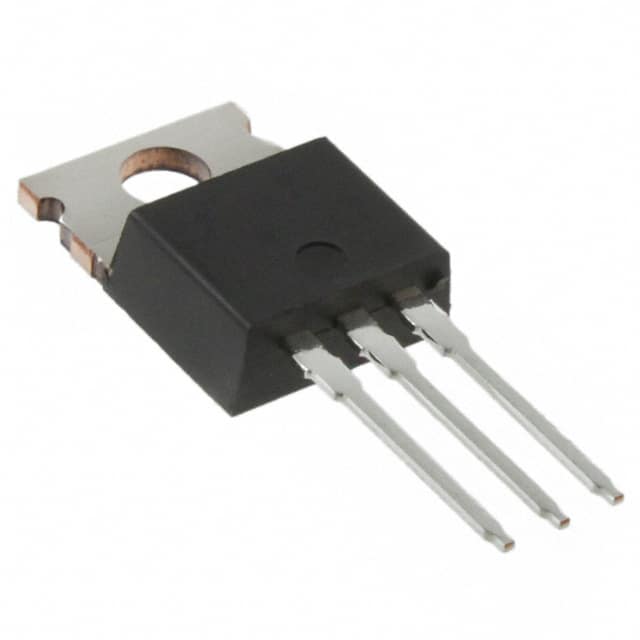Voir les spécifications pour les détails du produit.

IRF9610
Product Overview
Category
The IRF9610 belongs to the category of power MOSFETs.
Use
It is commonly used as a switching device in electronic circuits, particularly in power supply and motor control applications.
Characteristics
- High voltage capability
- Low on-resistance
- Fast switching speed
- Low gate drive power
Package
The IRF9610 is typically available in a TO-220 package.
Essence
The essence of the IRF9610 lies in its ability to efficiently control high-power circuits with minimal heat dissipation.
Packaging/Quantity
It is usually packaged in reels or tubes, with quantities varying based on manufacturer specifications.
Specifications
- Drain-Source Voltage (VDS): 200V
- Continuous Drain Current (ID): 1.8A
- On-Resistance (RDS(on)): 2.5Ω
- Gate-Source Voltage (VGS): ±20V
- Total Power Dissipation (PD): 25W
Detailed Pin Configuration
The IRF9610 has three pins: 1. Gate (G) 2. Drain (D) 3. Source (S)
Functional Features
- High input impedance
- Low input capacitance
- Enhanced thermal performance
Advantages
- Suitable for high voltage applications
- Low conduction losses
- Fast switching speed
Disadvantages
- Limited continuous current handling capacity
- Sensitivity to static electricity
Working Principles
The IRF9610 operates based on the principle of field-effect transistors, where the flow of current between the drain and source terminals is controlled by the voltage applied to the gate terminal.
Detailed Application Field Plans
The IRF9610 is widely used in: - Switching power supplies - Motor control circuits - Audio amplifiers - LED lighting systems
Detailed and Complete Alternative Models
Some alternative models to the IRF9610 include: - IRF9530 - IRF9540 - IRF840 - IRF640
In conclusion, the IRF9610 power MOSFET offers high voltage capability, fast switching speed, and low on-resistance, making it suitable for various power control applications. Its limitations include sensitivity to static electricity and limited continuous current handling capacity. However, when used within its specified parameters, the IRF9610 provides efficient and reliable performance in diverse electronic circuits.
Word Count: 311
Énumérez 10 questions et réponses courantes liées à l'application de IRF9610 dans les solutions techniques
What is the IRF9610?
- The IRF9610 is a P-channel power MOSFET commonly used in electronic circuits for switching and amplification applications.
What are the key specifications of the IRF9610?
- The IRF9610 has a maximum drain-source voltage (Vds) of -200V, a continuous drain current (Id) of -1.8A, and a low on-resistance (Rds(on)).
How can the IRF9610 be used in switching applications?
- The IRF9610 can be used to control high-power loads such as motors, solenoids, and relays by acting as a switch in electronic circuits.
In what types of amplification circuits can the IRF9610 be utilized?
- The IRF9610 can be used in audio amplifiers, power supply circuits, and other applications where P-channel MOSFETs are required for signal amplification.
What are the typical operating conditions for the IRF9610?
- The IRF9610 is typically operated within a specified temperature range and voltage limits to ensure proper performance and reliability.
How does the IRF9610 compare to similar MOSFETs in terms of performance?
- The IRF9610 offers a balance of low on-resistance, high voltage capability, and fast switching characteristics compared to other P-channel MOSFETs.
Are there any specific considerations for driving the IRF9610 in a circuit?
- Proper gate voltage levels, gate drive circuitry, and protection against overvoltage or overcurrent conditions should be considered when using the IRF9610.
Can the IRF9610 be used in automotive or industrial applications?
- Yes, the IRF9610's rugged construction and high voltage capability make it suitable for use in automotive and industrial environments.
What are the common failure modes of the IRF9610 and how can they be mitigated?
- Common failure modes include thermal overstress and overvoltage conditions, which can be mitigated through proper heat sinking and voltage protection measures.
Where can I find detailed application notes and reference designs for using the IRF9610 in technical solutions?
- Detailed application notes and reference designs for the IRF9610 can be found in the manufacturer's datasheets, application guides, and online resources.

